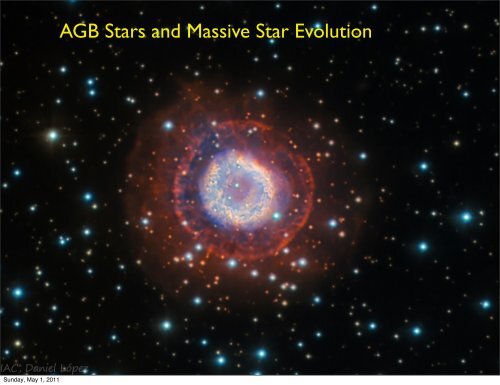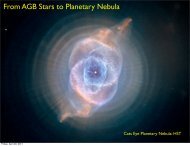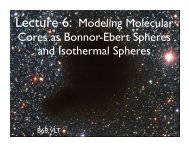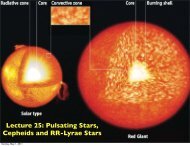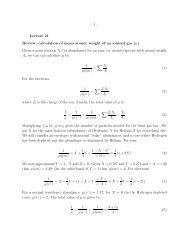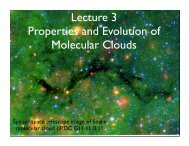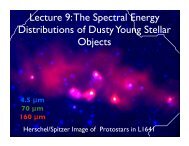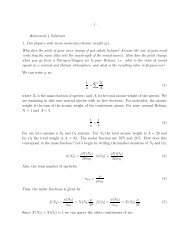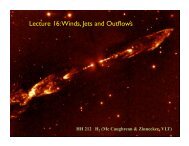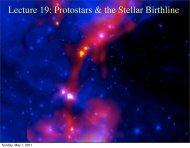Lecture 24: AGB Stars and Massive Star Evolution
Lecture 24: AGB Stars and Massive Star Evolution
Lecture 24: AGB Stars and Massive Star Evolution
Create successful ePaper yourself
Turn your PDF publications into a flip-book with our unique Google optimized e-Paper software.
Sunday, May 1, 2011<br />
<strong>AGB</strong> <strong><strong>Star</strong>s</strong> <strong>and</strong> <strong>Massive</strong> <strong>Star</strong> <strong>Evolution</strong>
Sunday, May 1, 2011<br />
Iben
The Helium Flash (< 2 Msun)<br />
The central core becomes dense enough, that degeneracy pressure<br />
dominates over thermal pressure. Still, the core radiates energy <strong>and</strong><br />
continues to contract, until Helium fusion occurs.<br />
Helium burning<br />
Once He fusion stars, temperature goes up, but core doesn’t exp<strong>and</strong><br />
immediately. This creates a brief burst of energy, much of which goes<br />
into inflating the core <strong>and</strong> star..<br />
Sunday, May 1, 2011
Degeneracy occurs<br />
when there are not<br />
enough quantum states<br />
at low velocities, pushing<br />
electrons to higher<br />
momentum (i.e. velocity)<br />
states.<br />
From Bohm Vitense<br />
Sunday, May 1, 2011
Nuclear Burning: the triple α process<br />
4 He + 4 He -> 8 Be<br />
8 Be+ 4 He -> 12 C<br />
q = k ρ 2 T 40<br />
Releasing 7.275 Mev (compared 25 Mev<br />
for Hydrogen burning)<br />
When enough carbon accumulates:<br />
12 CO + 4 He -> 16 O<br />
Releasing 7.162 Mev<br />
Sunday, May 1, 2011
The Horizontal Branch<br />
The core exp<strong>and</strong>s <strong>and</strong> nuclear reaction rates <strong>and</strong> luminosity may<br />
decrease. The star then enters a helium burning main sequence.<br />
Helium burning<br />
Hydrogen burning<br />
At this point the star is relatively steady for 10 8 years. However,<br />
pulsations may occur. Luminosities of 50-100 Lsun.<br />
Sunday, May 1, 2011
Eddington<br />
Luminosity<br />
http://www.atlasoftheuniverse.com/hr.html<br />
http://stars.astro.illinois.edu/sow/hrd.html<br />
Sunday, May 1, 2011
Piotto et al.<br />
RR Lyrae gap<br />
2002<br />
Less Envelope<br />
More Envelope<br />
Sunday, May 1, 2011
Asymptotic Giant Branch<br />
Now the central carbon/oxgen core becomes unstable <strong>and</strong> starts<br />
to contract. There is now Helium <strong>and</strong> Hydrogen burning in shells.<br />
Helium burning<br />
Hydrogen burning<br />
The star may become a supergiant. However, pulsations <strong>and</strong> dust<br />
formation in the envelope may lead to the ejection of the envelope,<br />
leaving a white dwarf.<br />
Sunday, May 1, 2011
MS<br />
Sub-giant<br />
to Giant<br />
Horizontal<br />
Branch<br />
<strong>AGB</strong><br />
Prialnik<br />
Sunday, May 1, 2011
Thin Shell Instabilities<br />
In Hydrostatic Equilibrium<br />
Prialnik<br />
Sunday, May 1, 2011
Imagine layers exp<strong>and</strong>s. If pressure from surrounding gas (i.e.<br />
hydrostatic equilibrium) drops faster than the pressure in<br />
expansion, layer continues to exp<strong>and</strong> <strong>and</strong> cool. If not,<br />
temperature rises <strong>and</strong> we get thermal instability.<br />
Prialnik<br />
Sunday, May 1, 2011
H -> He<br />
in convective<br />
region<br />
Dredge Up<br />
Prialnik<br />
Sunday, May 1, 2011
<strong>AGB</strong> stars pulsing<br />
Schwarzchild &<br />
Harm (1967)<br />
Sunday, May 1, 2011
The 9th Cycle<br />
Schwarzchild & Harm (1967)<br />
Sunday, May 1, 2011
Carbon Burning<br />
12 C + 12 C -> <strong>24</strong> Mg + γ<br />
12 C + 12 C -> 23 Mg + n<br />
12 C + 12 C -> 23 Na + p<br />
~13 ΜeV per reaction<br />
12 C + 12 C -> 20 Ne + α<br />
12 C + 12 C -> 16 Ο + 4α<br />
Sunday, May 1, 2011
When does degeneracy happen?<br />
Prialnik<br />
Sunday, May 1, 2011
Carbon<br />
Burning in<br />
Intermediate<br />
Mass <strong>AGB</strong><br />
<strong><strong>Star</strong>s</strong><br />
Siess et al. 2006<br />
Sunday, May 1, 2011
Carbon<br />
Burning in<br />
Intermediate<br />
Mass <strong>AGB</strong><br />
<strong><strong>Star</strong>s</strong><br />
Siess et al. 2006<br />
Sunday, May 1, 2011
Sunday, May 1, 2011<br />
Prumo & Siess 2007
Sunday, May 1, 2011
Sunday, May 1, 2011
The Supergiant Branch<br />
Relatively Constant Luminosity<br />
http://www.atlasoftheuniverse.com/hr.html<br />
http://stars.astro.illinois.edu/sow/hrd.html<br />
Sunday, May 1, 2011
Sunday, May 1, 2011<br />
Prialnik
The Blue Loop Excursions<br />
Contracting core <strong>and</strong> Hydrogen shell burning lead to large envelope <strong>and</strong> red colors.<br />
Helium burning in core implies exp<strong>and</strong>ed core <strong>and</strong> shell, smaller envelope <strong>and</strong> bluer colors.<br />
Sunday, May 1, 2011
The Blue Loop Excursions<br />
Sunday, May 1, 2011
<strong>Massive</strong> <strong>Star</strong> <strong>Evolution</strong><br />
Maeder et al. 1990 A&AS 84, 139<br />
Sunday, May 1, 2011
Sunday, May 1, 2011
Sunday, May 1, 2011
Semi-Convection<br />
Opacity per mass higher for Hydrogen then Helium<br />
(more electrons per mass)<br />
Imagine core of 40% Helium surrounded by an<br />
envelope layer of mostly 10% Helium. High<br />
opacity leads to convection, which mixes Helium<br />
into envelope, lowering opacity.<br />
Thus, such regions may have slow convection just<br />
to keep material mixed.<br />
Sunday, May 1, 2011
Sunday, May 1, 2011
Summary<br />
Asymptotic Giant Branch phase occurs after Helium core burning.<br />
Thin shell instability in helium burning leads to pulsations.<br />
These pulsations lead to significant change in luminosity. Helium <strong>and</strong><br />
Hydrogen shell burning alternate.<br />
Intermediate mass <strong>AGB</strong> stars may have carbon burning phase.<br />
<strong>Massive</strong> stars shown mainly evolution in temperature (close to<br />
Eddington limit). Mass loss important.<br />
Contains nested shells of nuclear burning, up to Iron<br />
Semi-convection mixes hydrogen <strong>and</strong> helium in core,<br />
Sunday, May 1, 2011


